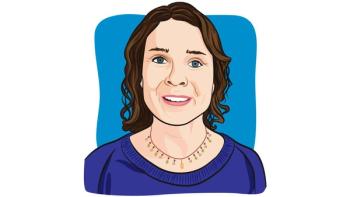
Drafted as a Soldier of Cancer
After receiving a diagnosis of medulloblastoma at age 11, one woman has lived decades with the disease as her uninvited companion. Now, she writes, speaks and advocates for others facing cancer.
When I was 11 years old, my dream was to be on the TV show “Star Search.” I loved singing, dancing and being my mom's little model. When we found out that “Star Search” was having auditions, my mom mailed in for an application and sent them a video of me singing and dancing. I could not believe that we were invited to the auditions. My mom wasted no time in spreading the word around our neighborhood.
We were two weeks away from my trip to California, and that's the closest I got to my dream. My plans were interrupted by a diagnosis of a medulloblastoma brain tumor. The doctor at our local hospital in Staten Island told my parents to make me comfortable; I was given six months to a year to live. By chance, we bumped into a pediatric neurologist who was affiliated with NYU Hospital. There, I was introduced to a pediatric neurologist and two pediatric neurosurgeons who saved my life.
My welcoming roommate, doctors and staff members told me all about the wonderful things NYU had to offer. They had an activity room where kids could play video games, bake and make arts and crafts. My family members added an extra infusion of hope and humor. I was the new kid on the block during that period, but not for long. I didn’t know it yet, but I had been drafted as a soldier of cancer.
Soon afterwards, I learned that my cancer had spread to my spinal cord, and I was prescribed a year of chemotherapy and radiation. After the first week of chemo, I was very nauseated and lost my hair. The cool girl I used to be in school was gone, replaced by one who walked through the hallways with a bald head and black-and-blue arms from IVs. I was abused and tortured for wearing wigs that were ripped off my head by kids who were so cruel that I didn't consider them human. They changed the lyrics in popular songs of the ’80s to ridicule my appearance. "She wakes up every morning just to do her makeup, but she's hairless, she's hairless." Little did they know that, while they were lucky and healthy enough to go home after school, I had to go back to the hospital for MRIs and CT scans. I put up with it all because I wanted my education no matter what it cost me.
One day after my third week of chemo, my Auntie Annie, my mother’s oldest sister, gave me a picture of an Italian priest named Padre Pio; he later became a saint. Auntie told me all about this priest and the way he suffered with the stigmata. I developed an instant concern for him, but unfortunately, I threw up all over his picture. I also smelled an unusual smell. The following week when we went to NYU to discuss my status, the doctors looked at me as if they had seen a ghost. My parents wondered what kind of bad news they would get.
"Mr. and Mrs. Barbarino, we don't know how to tell you this," a doctor said. Right away, my parents’ heads went down." Aprilann is not even finished with her fourth week of chemo, and the most recent test shows she is in complete remission." Right away their heads went up. Wow! They couldn't believe it. When we told Auntie, she said that Padre Pio had brought us a miracle. "Aprilann was the only one who smelled an unfamiliar smell, and that's how I knew he was helping her,” she said. “When she threw up on his picture, that's when he took it all out of her."
Over the next three decades, my cancer came back 10 more times, but I beat it. Today, at 44, I am an educator with a master’s degree in education and a bachelor’s degree in English language arts. I am also an empirical author in the process of writing my first autobiography, “Solder of Cancer,” and I’m a guest speaker and advocate for those who continue to suffer, survive and fight this terrible disease.
I believe that each survivor’s story is needed today, more than ever. The more stories, the more glories that help to weaken cancer. As one cancer patient to another, we can solace each other.




